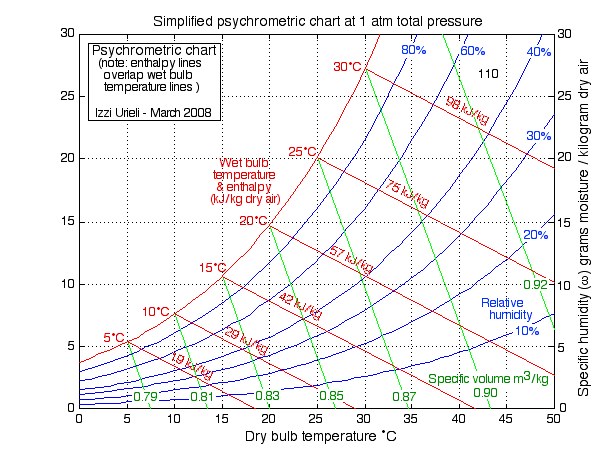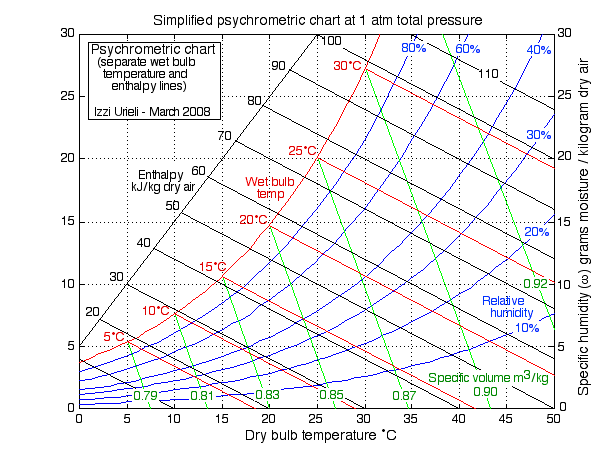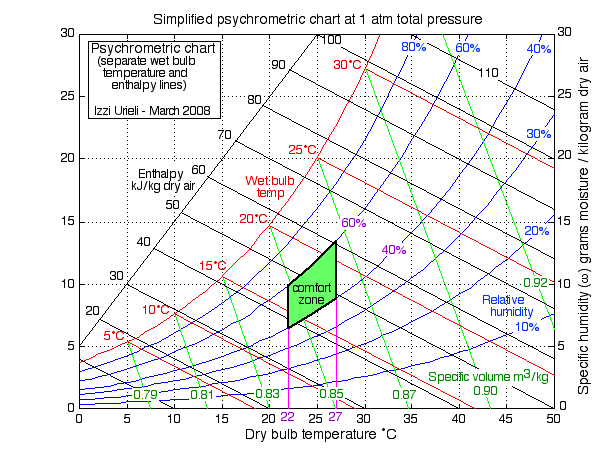
We notice from the development in Section a) that the equations relating relative and specific humidity, temperature (wet and dry bulb), pressure (air, vapor) and enthalpy are quite tedious and inconvenient. For this reason a Psychrometric Chart relating all the relevant variables was developed which is extremely useful for designing and evaluating air-conditioning and cooling tower systems.
At first appearence the psychrometric chart is quite confusing, however with some practice it becomes an extremely useful tool for rapidly evaluating air-conditioning processes. The most popular chart in common usage is that developed by ASHRAE (American Society of Heating, Refrigeration and Air-Conditioning Engineers), however we feel that the construction of a simplified version of the chart based on approximations of the various equations can be a very useful tool for developing an understanding of it's usage. This approach was suggested by Maged El-Shaarawi in his article "On the Psychrometric Chart" published in the ASHRAE Transactions (Paper #3736, Vol 100, Part 1, 1994) and inspired us to produce the following simplified psychrometric chart:

The basic information used to construct the chart is the water vapor saturation data (Tsat, Pg) which is obtained from steam tables over the range from Tsat = 0.01°C through 50°C. The specific humidity ω is then evaluated using the relative humidity φ as a parameter to produce the various relative humidity curves (blue lines) as follows:
where P is the standard atmospheric pressure 101.325 [kPa].
The saturation curve (100% relative humidity) also known as the dew point curve is drawn as a red line. Notice that on the saturation curve the wet and dry bulb temperatures have the same values.
The major simplifying assumption in the construction of the chart is that the enthalpy of the mixture is assumed to be constant throughout the adiabatic saturation process (described in Section a). This implies that the evaporating liquid added does not significantly affect the enthalpy of the air-vapor mixture, leading to the constant slope wet bulb temperature / enthalpy (red) lines defined by:
Note that on the ω = 0 axis (dry air) h = T [°C]
Finally, the specific volume of the air-vapor mixture (green lines) is determined from the ideal gas relation as
where the gas constant Rair = 0.287 [kJ/kg.K]
It is normal practice to separate out the overlapping enthalpy / wet bulb temperature lines allowing them to be separately evaluated. Thus we introduce an oblique enthalpy axis and enthalpy (black) lines as follows:

The four equations highlighted above were programmed
in MATLAB and used to plot the simplified psychrometric charts shown
above. Refer to the link:
MATLAB
program for plotting a Simplified Psychrometric Chart
An excellent NebGuide (University of Nebraska-Lincoln Extension Publication) describing How to use a Simplified Psychrometric Chart has been provided by David Shelton and Gerald Bodman. Another useful guide provided by Mark Cartwright of the North Carolina Contractor Testing Institute (NCCTI) is the YouTube video: Psychrometric Chart Simplified. Both guides reduce the confusion by separately explaining 4 of the 6 sets of curves which make up a psychrometric chart. Definitely review both guides before continuing.
Solved Problem 10.1 - Assume that the outside air temperature is 32°C with a relative humidity φ = 60%. Use the psychrometric chart to determine the specific humidity ω [18 gm-moisture/kg-air], the enthalpy h [78 kJ/kg-air], the wet-bulb temperature Twb [25.5°C], the dew-point temperature Tdp [23°C], and the specific volume of the dry air v [0.89m3/kg]. Indicate all the values determined on the chart.

Solved Problem 10.2: Assume that the outside air temperature is 8°C. If the air in a room is at 25°C with a relative humidity φ = 40%, use the psychrometric chart to determine if the windows of that room which are in contact with the outside will become foggy.
The
air in contact with the windows will become colder until the dew
point is reached. Notice that under the conditions of 25°C and 40%
relative humidity the dew point temperature is slightly higher than
10°C, At that point the water vapor condenses as the temperature
approaches 8°C along the saturation line, and the windows will
become foggy.
______________________________________________________________________________________
One of the major applications of the Psychrometric Chart is in air conditioning, and we find that most humans feel comfortable when the temperature is between 22°C and 27°C, and the relative humidity φ between 40% and 60%. This defines the "comfort zone" which is portrayed on the Psychrometric Chart as shown below. Thus with the aid of the chart we either heat or cool, add moisture or dehumidify as required in order to bring the air into the comfort zone.

Solved Problem 10.3: Outside air at 35°C and 60% relative humidity is to be conditioned by cooling and heating so as to bring the air to within the "comfort zone". Using the Psychrometric Chart neatly plot the required air conditioning process and estimate (a) the amount of moisture removed [11.5g-H20/kg-dry-air], (b) the heat removed [(1)-(2), qcool = 48kJ/kg-dry-air], and (c) the amount of heat added [(2)-(3), qheat = 10kJ/kg-dry-air].

Solved Problem 10.4:: Hot dry air at 40°C and 10% relative humidity passes through an evaporative cooler. Water is added as the air passes through a series of wicks and the mixture exits at 27°C. Using the psychrometric chart determine (a) the outlet relative humidity [45%], (b) the amount of water added [5.4g-H20/kg-dry-air], and (c) the lowest temperature that could be realized [18.5°C].

This type of cooler is extremely popular in hot, dry climates, and is popularly known as a Swamp Cooler. An interesting application of using a swamp cooler to cool drinking water in extremely hot environments is described in the posting of Rich Oppel in the At War blog of the New York Times: 'Drinking From Socks'.
An interesting and informative description on Psychrometric Chart Use for livestock and greenhouse applications has been presented in a PennState Extension website by Eileen E. Fabian. Other websites that we found interesting is that of Wikipedia on Psychrometrics.
______________________________________________________________________________________
![]()
Engineering Thermodynamics by Israel
Urieli is licensed under a Creative
Commons Attribution-Noncommercial-Share Alike 3.0 United States
License